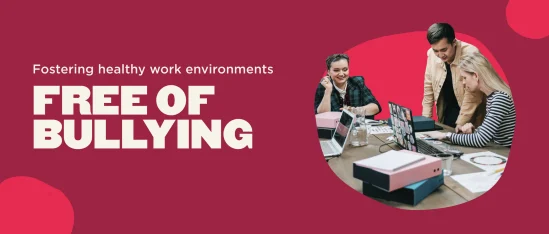I would like to discuss one of the most influential factors on employee mental health in modern office settings: workplace bullying. Once regarded as incidents that only took place on school playgrounds, bullying now runs rampant in offices and other workspaces, leading to a high negative financial impact for companies.
According to Forbes, workplace bullying costs the U.S. economy an estimated $360 billion annually due to high turnover and diminished work productivity. Research conducted by Monster.com, the global employment service, found that 90 percent of workers have been bullied at work. The research found that 51 percent reported being bullied by a superior and 39 percent were bullied by a co-worker. A similar survey conducted by CareerBuilder.com found that 56 percent of LGBT workers reported being bullied. This is why experts refer to workplace bullying as the “silent epidemic” in today’s office environments.
What is bullying?
Bullying can be intentional, repeated, aggressive behavior that takes place over a period of time, and has a devastating effect on those targeted. In this article, we discuss different types of workplace bullying.
Physical bullying
Physical bullying involves unwanted physical contact that is meant to assert power. It takes place when a person, their possessions, or property are subjected to physical assault. Physical assault causes bodily harm by hitting, kicking, tripping, shoving, punching, and vandalizing.
Verbal bullying
Various forms of verbal abuse undermine self-esteem and exert control. Verbal attacks involve insults, mocking, taunting, homophobic or racist remarks, inappropriate sexual comments, or threats that create fear and cause emotional distress.
Social bullying
Social bullying may be tricky to notice because it can be conducted covertly and does not always take place in the presence of the target. Sometimes, this type of bullying starts as a baseless rumor or nasty gossip that quickly gets out of hand. Social bullying damages a person’s social standing, reputation, or relationships, and often dents self-confidence. Social bullying also includes gesturing (bodily or facial), and pranks that humiliate, embarrass, or isolate people.
Cyberbullying
With the proliferation of devices like smartphones, tablets, gaming consoles, and computers, cyberbullying has become prevalent online. Cyberbullies often send abusive and disparaging texts, posts, emails, hate speech, and offensive images. A cyberbully can be someone you know or an anonymous stranger. However, with cyberbullying, there’s a good chance hundreds or even thousands of people experience intense anguish in the digital space.
Recommended For Further Reading
Bullying and mental health
According to Mind the Workplace, a report by Mental Health America (MHA), workplace mental health has received increased attention in recent years, in large part because it’s been directly linked to an annual loss of 500 billion dollars in productivity and performance. But the loss is more than financial. Overstressed, anxious, and unhealthy employees contribute to the creation of unhappy workplaces and lower overall employee morale.
A different study undertaken in the UK revealed that exposure to workplace bullying increases the risk of developing depressive and anxiety disorders, along with PTSD symptoms and stress-related psychological complaints.
The same study also found that 33 percent of patients with mood disorders attribute their mental health struggles to their work situation, citing problems and unhappiness at work as the most common self-reported cause of depression. The fact that work can have a significant negative impact on mental health isn’t surprising, especially since people spend the majority of their days at the office.
How can managers prevent workplace bullying?
Eitan Meiri, an expert psychologist in the field of Abuse and Bullying, shared his top 6 steps that management can adopt to prevent workplace bullying with me.
According to Meiri, the first step is for companies to implement a clear no-tolerance policy that specifies bullying in any form will not be tolerated. If bullying occurs, it will be addressed with disciplinary procedures.
This next step is publicizing the policy so that all team members are made aware of the company’s standards regarding unacceptable behavior. The policy should be presented across the organization. If done well, it should promote company-wide awareness and healthy modes of communication.
Measure and track using effective tools or products that help analyze the atmosphere at work and detect the risk of offensive behaviors. With the right tools to measure employees’ experiences, companies can identify potential behaviors before they escalate, and maintain a positive and healthy work environment.
Facilitate anti-bullying training at the management level, as well as for the rest of the company’s employees. In addition to sensitivity training, managers should be trained on how to take appropriate action after receiving employee complaints and on ways to resolve them.
Nominate a professional contact that is reliable and trained. The contact should be internal and accessible to every employee who needs to reach out if they are being bullied or if they see someone else being a bully.
Establish a detailed process for dealing with any bullying incidents. The process can include grievance procedures, investigations, the timescale for action, and counseling.
As companies continue to look for ways to improve employee experience, they should remember that creating a favorable work environment does wonders for employee morale. It’s also a major driver for happy and healthy work cultures. We spend a large part of our time at work and incorporating the right measures against bullying can help managers better influence their employees’ day-to-day lives, resulting in a positive and more inclusive workplace.

From Shiran Yaroslavsky
Shiran Yaroslavsky is the VP Product US at HiBob. She is the former CEO and Co-founder of Cassiopeia (acquired by HiBob), a startup that helps managers lead teams effectively with data. Shiran is a thought leader in people analytics and remote team leadership. She was featured in 2019 in Forbes’ 30Under30 list in Israel.

